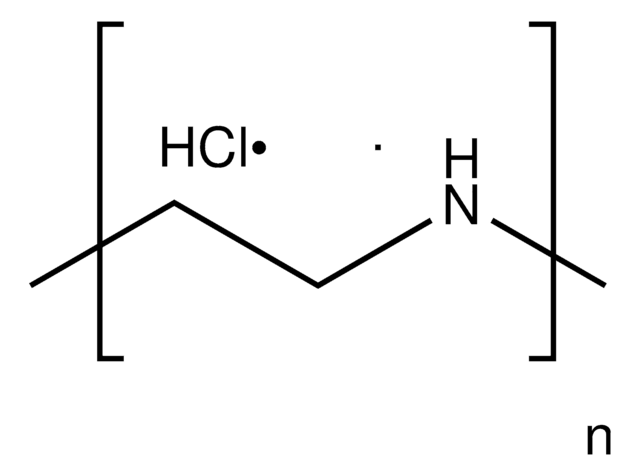306185
Polyethylenimine
80% ethoxylated solution, 37 wt. % in H₂O
Sinónimos:
PEI
About This Item
Productos recomendados
Nombre del producto
Polyethylenimine, 80% ethoxylated solution, 37 wt. % in H2O
form
liquid
Quality Level
mol wt
Mw 110,000
concentration
37 wt. % in H2O
pH
12
transition temp
pour point 0 °C
density
1.08 g/mL at 25 °C
¿Está buscando productos similares? Visita Guía de comparación de productos
Application
Features and Benefits
signalword
Warning
hcodes
Hazard Classifications
Acute Tox. 4 Oral - Eye Irrit. 2 - Skin Irrit. 2
Storage Class
10 - Combustible liquids
wgk_germany
WGK 3
flash_point_f
Not applicable
flash_point_c
Not applicable
ppe
Eyeshields, Gloves, multi-purpose combination respirator cartridge (US)
Elija entre una de las versiones más recientes:
¿Ya tiene este producto?
Encuentre la documentación para los productos que ha comprado recientemente en la Biblioteca de documentos.
Los clientes también vieron
Artículos
Gene therapy has become one of the most discussed techniques in biomedical research in recent years.
The CRISPR/Cas9 system has recently emerged as a highly specific, efficient, and versatile gene editing technology that can be utilized to build disease models and correct diseased genes. Safe and effective delivery vectors for the CRISPR/Cas9 system are in critical need to enable clinical development and future applications of CRISPR/Cas9 systems. Professor Yang Liu summarizes recent progress in nonviral nanoparticle approaches for CRISPR/Cas9 delivery.
We present an article that discusses two applications in particular; first, using these layers as polyelectrolyte membranes to control permeability.
Nuestro equipo de científicos tiene experiencia en todas las áreas de investigación: Ciencias de la vida, Ciencia de los materiales, Síntesis química, Cromatografía, Analítica y muchas otras.
Póngase en contacto con el Servicio técnico







